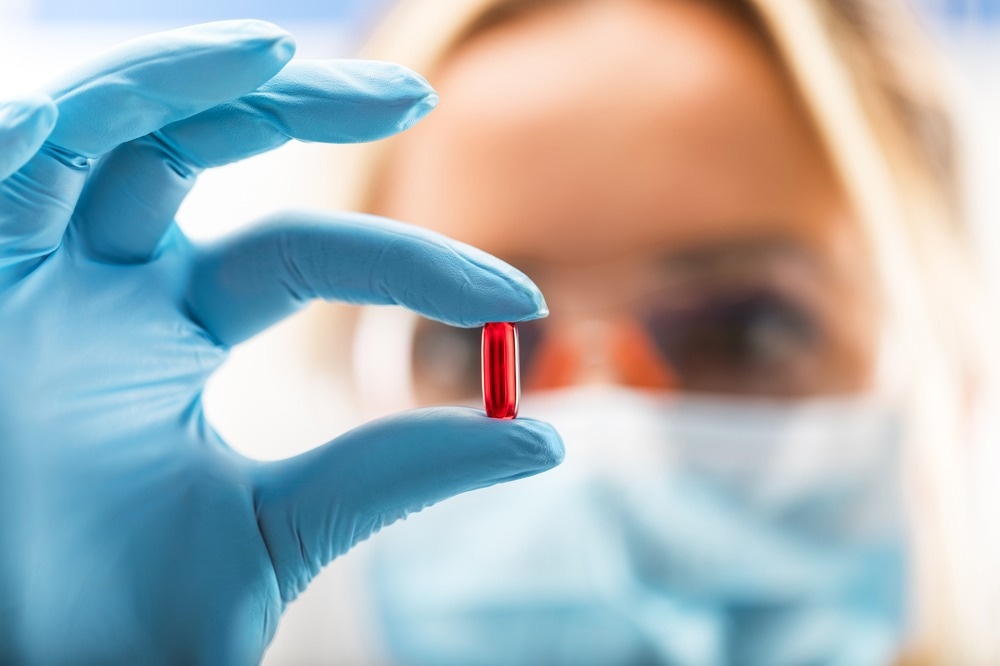Introduction
Molecular simulations
Coarse-grained modeling
Personalized medicine and other uses
References
Chemical and biochemical processes can be modeled in silico based on knowledge of the molecular structure of the species involved and understanding basic chemical interactions, allowing such processes to be described and experimented on. Computational experimentation has become particularly essential in pharmacology, where drug leads are identified and optimized in an extremely high-throughput manner compared to traditional in vitro testing.

Image Credit: Oleksiy Mark/Shutterstock.com
Molecular simulations
Virtual screening for drug leads considers the structure and chemical characteristics of the lead compound and target receptor to suggest modifications that would achieve greater affinity between the two, achieved by extensive knowledge of atomic and molecular properties. The earliest forms of virtual screening relied primarily on knowledge of the spatial arrangement of the binding site, which can be accurately described by techniques such as X-ray crystallography to identify lead compounds that fit neatly into the site.
The expansive list of potential drug leads produced by this method is cut down significantly by firstly identifying ligands with a good affinity towards the target site and making thousands of iterative modifications in silico prior to in vitro testing, whereupon each lead compound is scored based on the time taken to form a bond with the target site, and the stability of the bond thereafter. Therefore, various machine learning algorithms have been applied to in silico drug discovery that select and carry forward preferred features from each generation of tested compounds to optimize drug affinity to the active site.
Once the rules of molecular interaction are established in silico, simulations can be scaled up to model entire biochemical systems, such as cell membranes bearing the appropriate cell surface receptors, individual organelles, and even whole cells. For example, Karr et al. (2012) were able to computationally model every element of the pathogenic bacterium Mycoplasma genitalium using a combination of computational approaches, where the cell was divided into 28 compartmental models, each representing a cellular process or property that were independently constructed and integrated. I.e., independent mathematical models established to describe protein folding kinetics, translation kinetics, cell metabolism, etc., were combined to provide a holistic simulation of the cell.
In silico experiments using such models can be used to investigate therapeutics by simulating the drug or effect of gene or protein therapy and can further reveal fundamental or emergent properties of biochemical systems. For example, specific gene mutations were imposed on the model Mycoplasma genitalium cell, allowing the downstream influence and phenotypic effects towards each cellular process to be observed.
Coarse-grained modeling
On this scale, computational models rarely attempt to account for the movement and interacting properties of each molecule in the system and alternatively utilize mathematical models to generalize the behavior of a modeled component (coarse-grained modeling), saving time and computing resources. In the 1980s, during the early years of molecular dynamics simulations, few computers were capable of very detailed atomic-level simulations, and cellular features such as the membrane were modeled as a single entity.
During the 1990s, atomic level simulations became more feasible, and membrane models consisting of dozens of lipids could be simulated for hundreds of picoseconds. Modern simulations regularly contain tens of thousands of atoms and run for much longer periods, though generally still only microseconds, allowing emergent properties of the system to be recognized. While highly detailed atom-by-atom molecular dynamic simulations are invaluable in providing the kinetic and structural details of biochemical systems, coarse-grained models are still widely used and allow for much longer simulation times at the expense of detail.
Coarse-grained in silico modeling of tissues is also increasingly realized, where cell characteristics and the function of therapeutics can be investigated at the tissue level by simulating thousands of cells in 3D space, though it is not yet regularly used in biochemical research. Computational modeling of tissues is of particular interest in cancer research, where the full volume of the tumor might be modeled and allow high-throughput examination and detailed manipulation.
Whole-body models are employed to investigate drug and nanomaterials' biodistribution and pharmacokinetic properties. Such models compartmentalize each parameter included, which in this case may include separate mathematical models for adsorption rates across the intestinal epithelium, propensity towards elimination via the hepatobiliary system, rate of accumulation in adipose tissue, and other relevant factors.
Omics eBook

Pharmacokinetic-pharmacodynamic models such as these are utilized throughout the drug discovery and development process to estimate safety and efficacy, continuously informed by and informing in vitro and in vivo testing. Physiological parameters influenced by factors such as patient demographic and disease states can be tailored in such simulations to reflect variability amongst the expected recipient population, generating a robust dataset prior to expensive clinical testing.

Image Credit: grinimal/Shutterstock.com
Personalized medicine and other uses
In silico modeling at every scale: cell, tissue, organ, or full body, has enormous applications in the development of personalized medicine, where the specific genetic and phenotypic features of the patient or diseased region can be reflected in simulation. Such highly detailed models rely on accurate data collection in the clinic, though the clinical application does not necessarily require that new simulations be performed in every case, as robust experimentation will allow parameterization of demographics and disease states, identifying the optimal course of treatment given certain patient characteristics.
Besides its use in research, virtual biochemistry models are increasingly being developed and adopted in education to allow students to better visualize and understand complex systems. Interactive models that allow students to investigate and test the system frequently prove superior to text, diagrams, and video learning, and the potential of such resources is yet to be tapped.
Several virtual and augmented reality technology tools have been developed that allow students to examine and observe the function of, for example, proteins in their natural environment, and once further developed, such tools may also have intriguing applications in research, allowing scientists to better visualize and manipulate the elements of biochemistry under investigation.
Read Next: The Past, Present, and Future of Precision Medicine
References:
- Ekins, S. et al. (2007) In silico pharmacology for drug discovery: methods for virtual ligand screening and profiling. British Journal of Pharmacology, 152(1). https://www.ncbi.nlm.nih.gov/pmc/articles/PMC1978274/
- Karr, J. R. et al. (2012) A Whole-Cell Computational Model Predicts Phenotype from Genotype. Cell, 120. https://www.cell.com/action/showPdf?pii=S0092-8674%2812%2900776-3
- Monova, T. et al. (2018) Design and implementation of virtual models in medical biochemistry learning. AIP Conference Proceedings, 2048. https://aip.scitation.org/doi/pdf/10.1063/1.5082051
- Kim, S. H., Jackson, A. J. & Hunt, C. A. (2014) In Silico, Experimental, Mechanistic Model for Extended-Release Felodipine Disposition Exhibiting Complex Absorption and a Highly Variable Food Interaction. PLoS One, 9(9). https://www.ncbi.nlm.nih.gov/pmc/articles/PMC4182452/
- Edelman, L. B., Eddy, J. A. & Price, N. D. (2011) In silico models of cancer. Wiley Interdisciplinary Reviews: Systems Biology and Medicine, 2(4). https://www.ncbi.nlm.nih.gov/pmc/articles/PMC3157287/
- Lim, H-. S. (2019) Evolving role of modeling and simulation in drug development. Translational and clinical pharmacology, 27(1). https://www.ncbi.nlm.nih.gov/pmc/articles/PMC6989267/
- Sung, R-. J. et al. (2020) BiochemAR: An Augmented Reality Educational Tool for Teaching Macromolecular Structure and Function. Chemical Education, 97(1). https://pubs.acs.org/doi/10.1021/acs.jchemed.8b00691
Further Reading
- All Biochemistry Content
- What is Biochemistry?
- What is Bioorganic Chemistry?
- An Introduction to Enzyme Kinetics
- The Use of Biochemistry within Biotechnology
Last Updated: Feb 7, 2023

Written by
Michael Greenwood
Michael graduated from Manchester Metropolitan University with a B.Sc. in Chemistry in 2014, where he majored in organic, inorganic, physical and analytical chemistry. He is currently completing a Ph.D. on the design and production of gold nanoparticles able to act as multimodal anticancer agents, being both drug delivery platforms and radiation dose enhancers.
Source: Read Full Article
